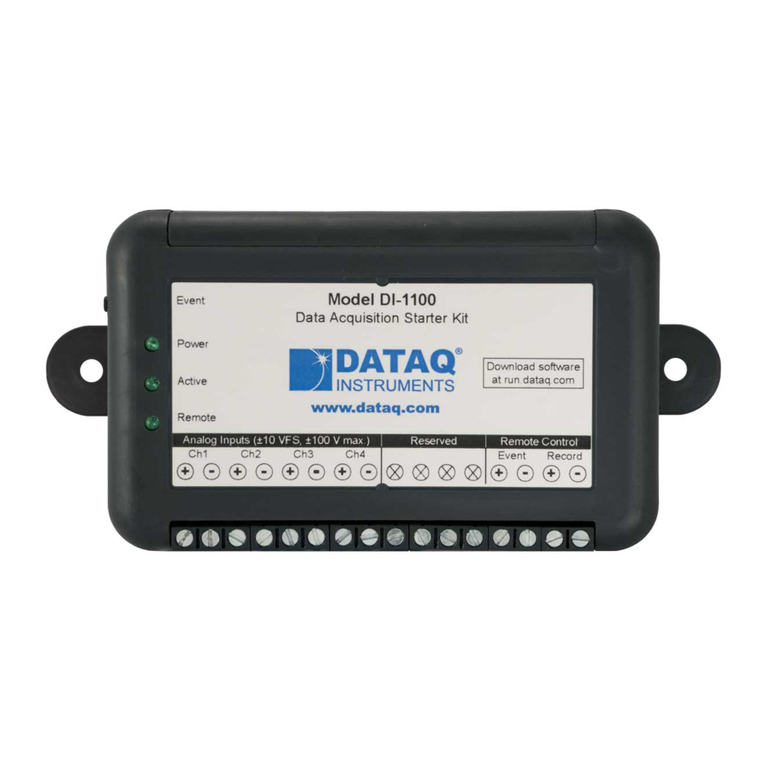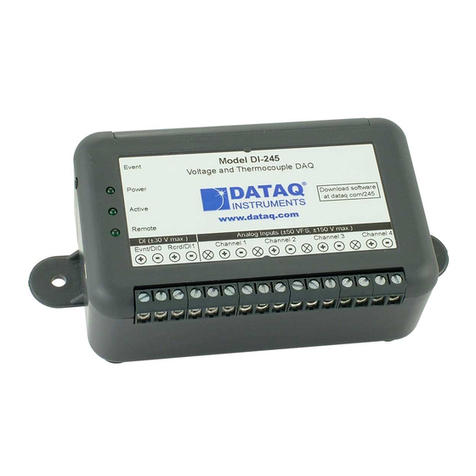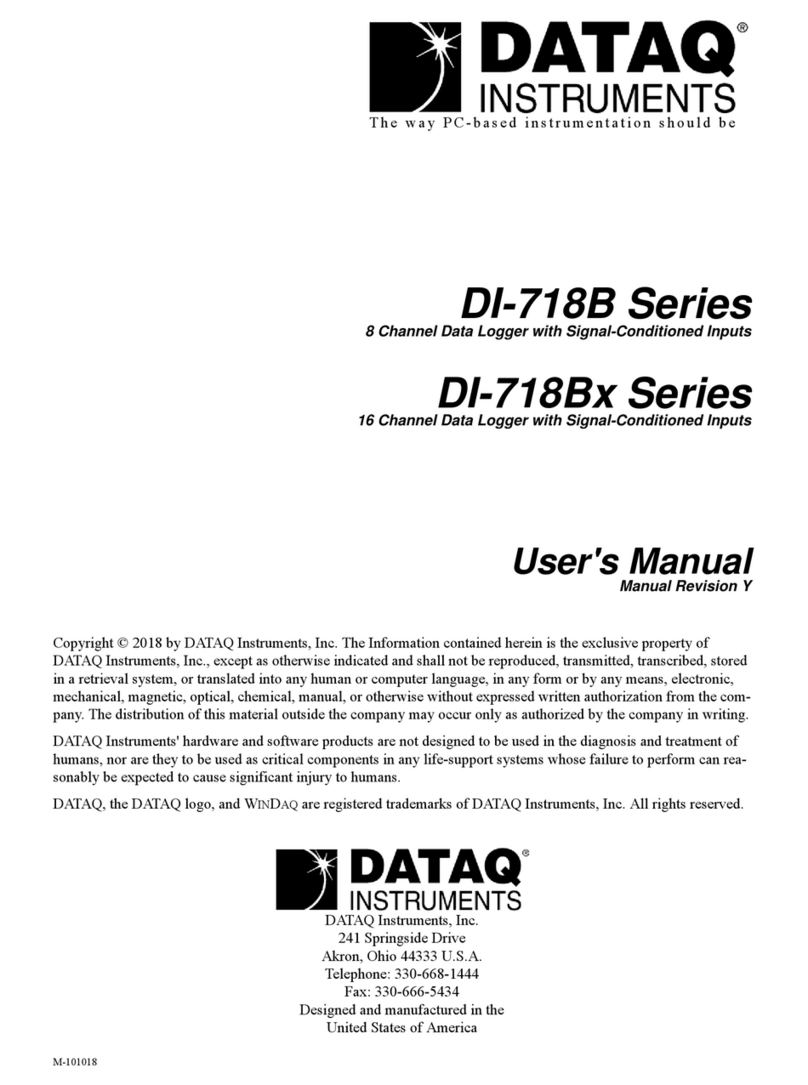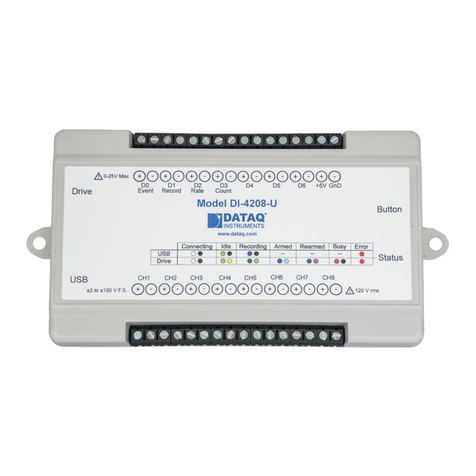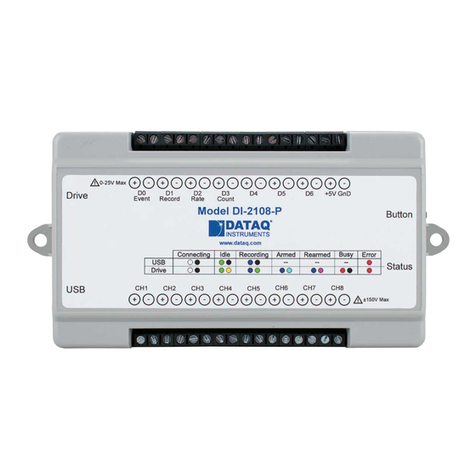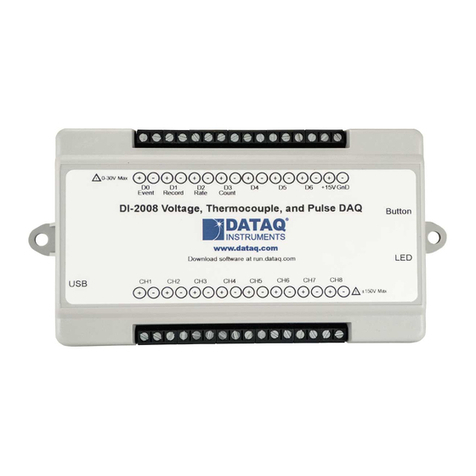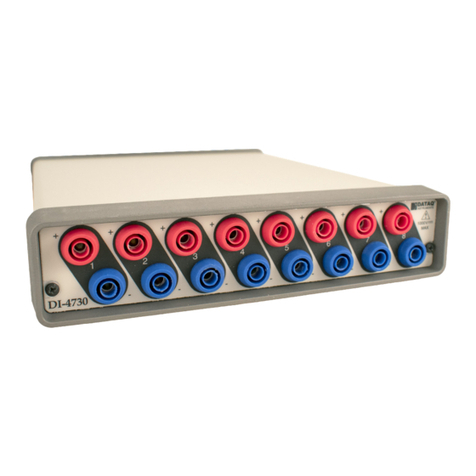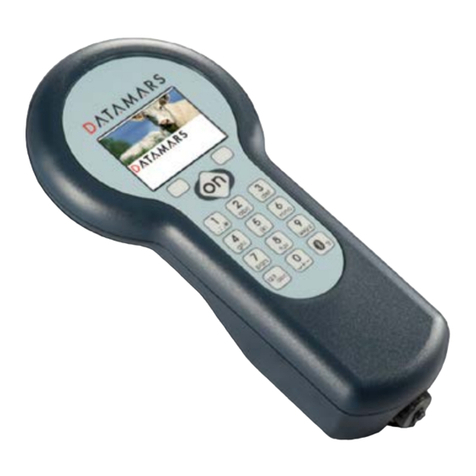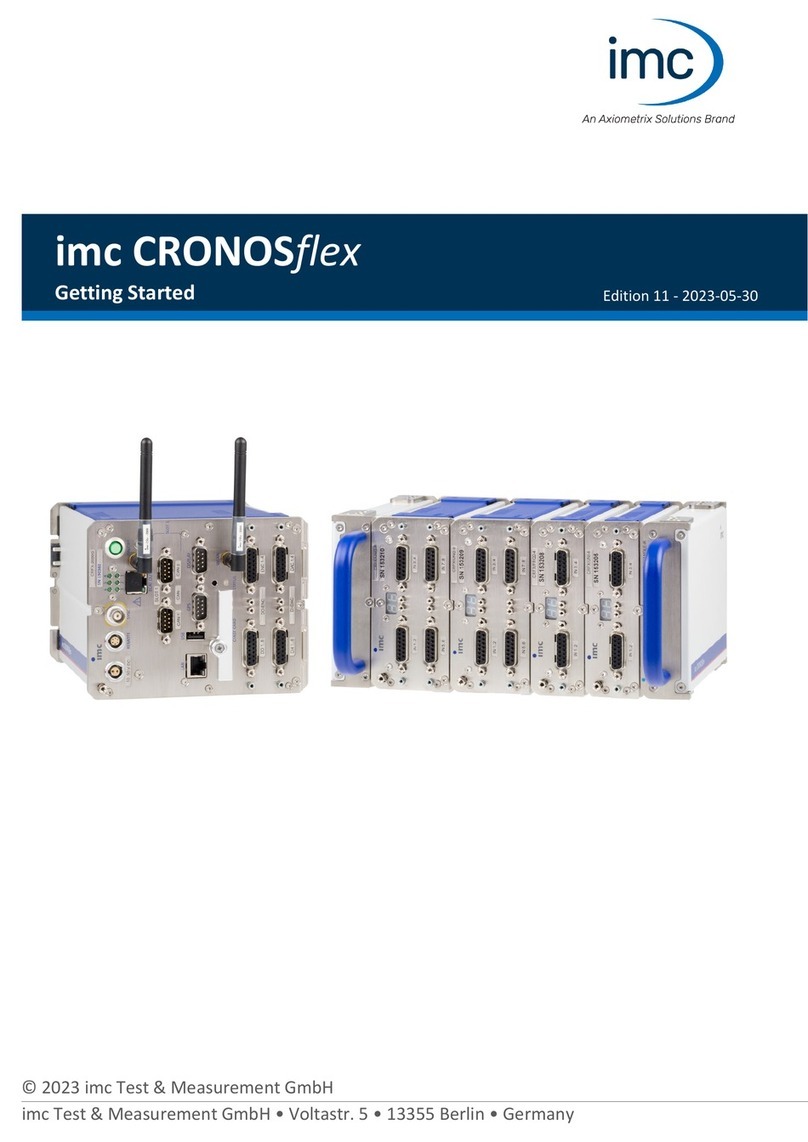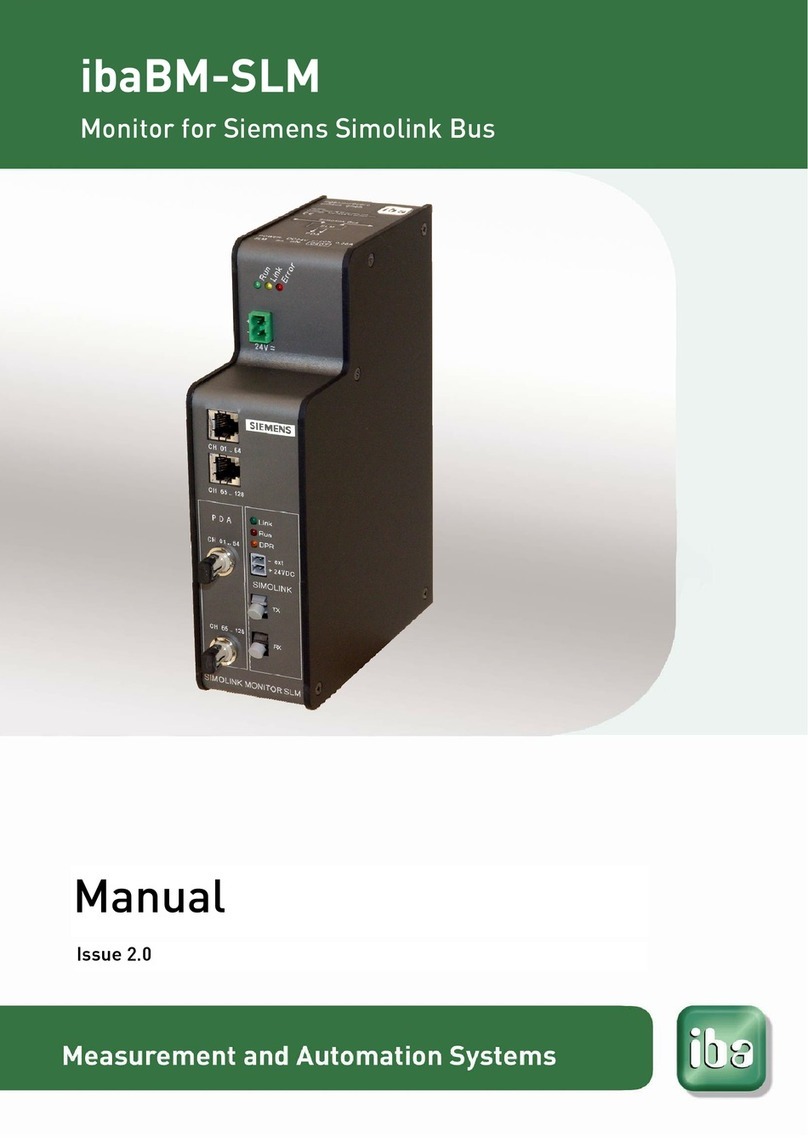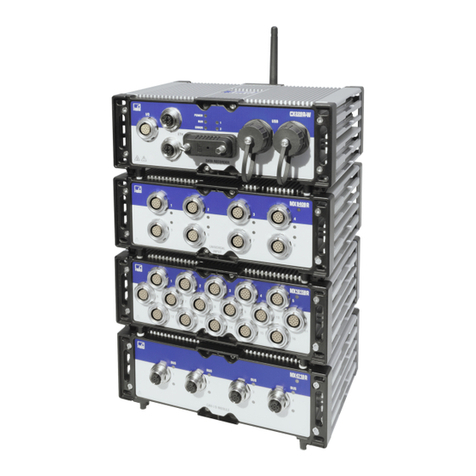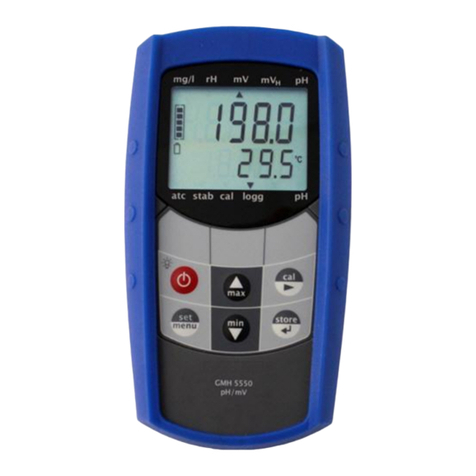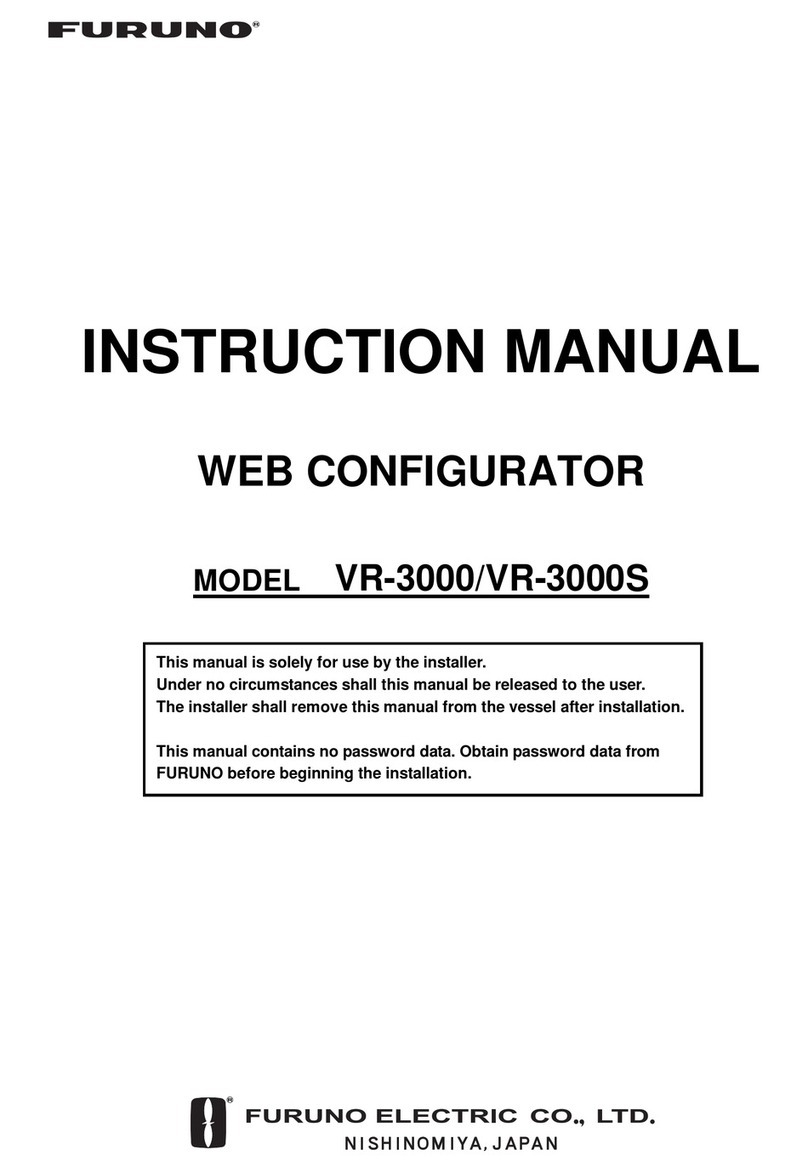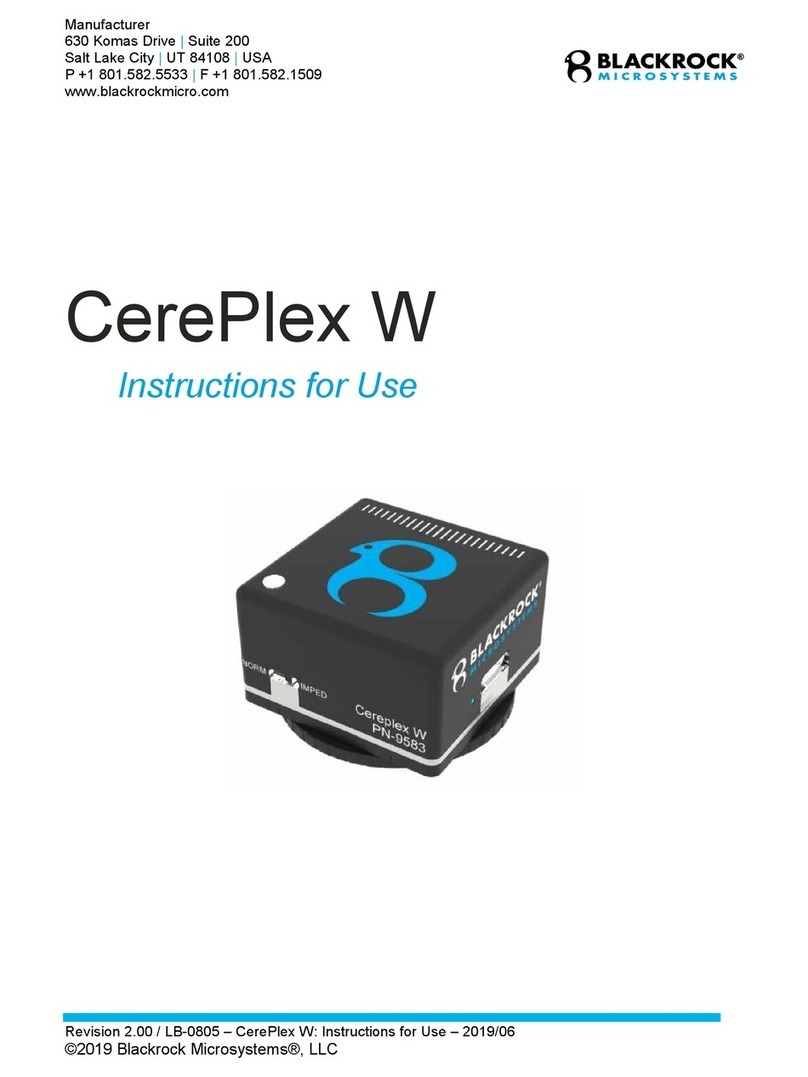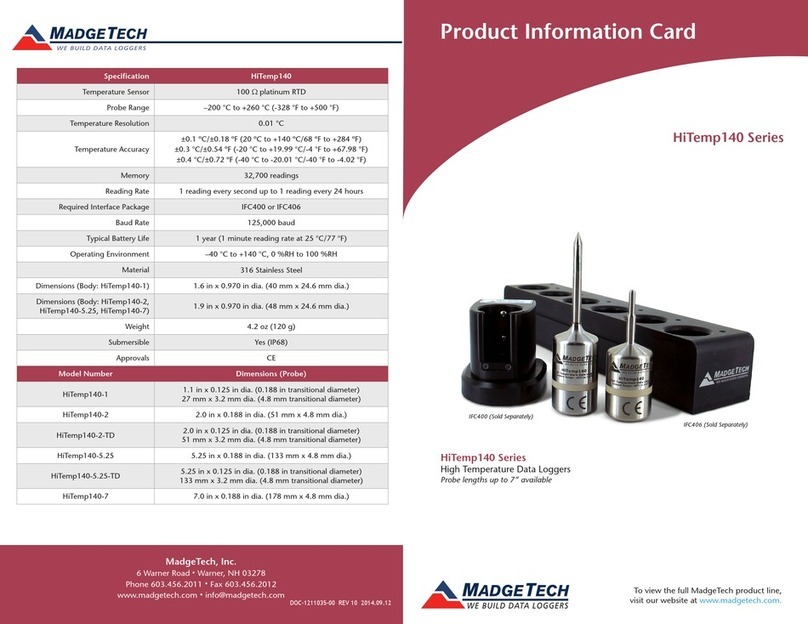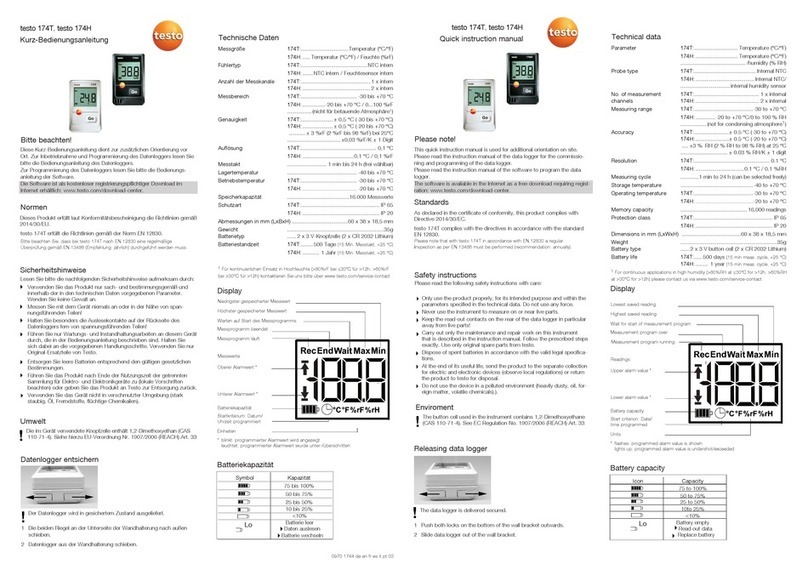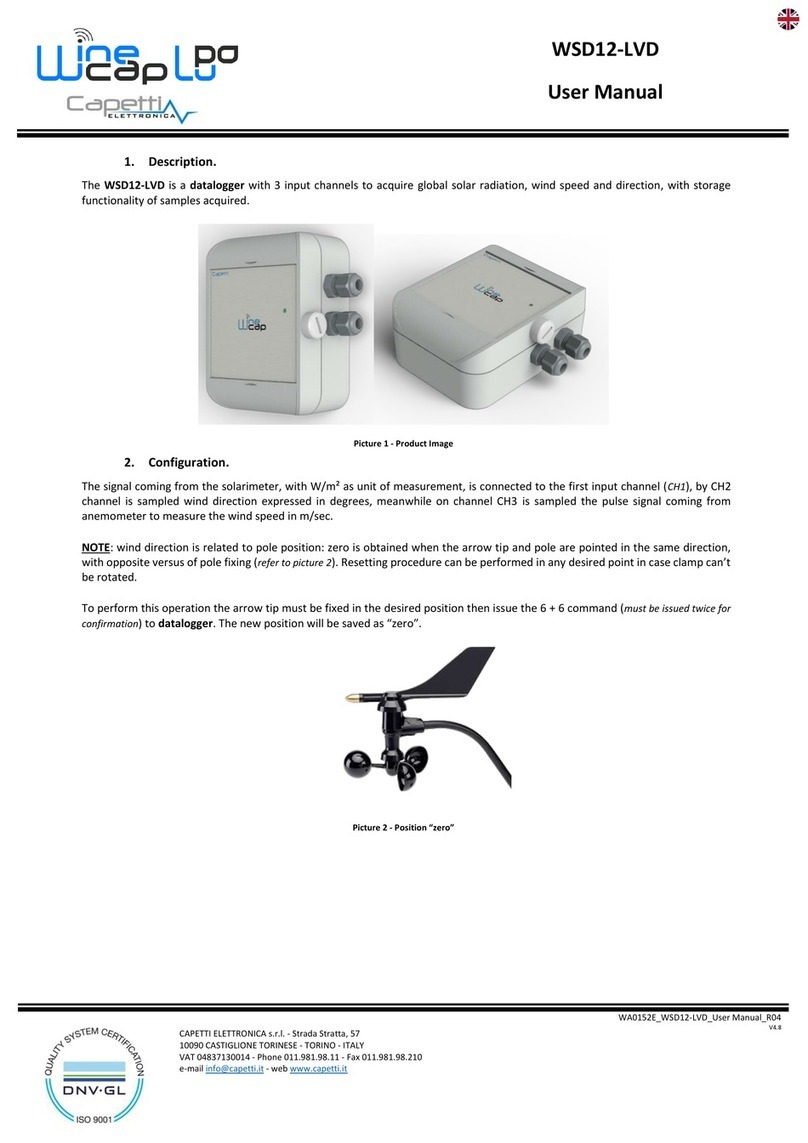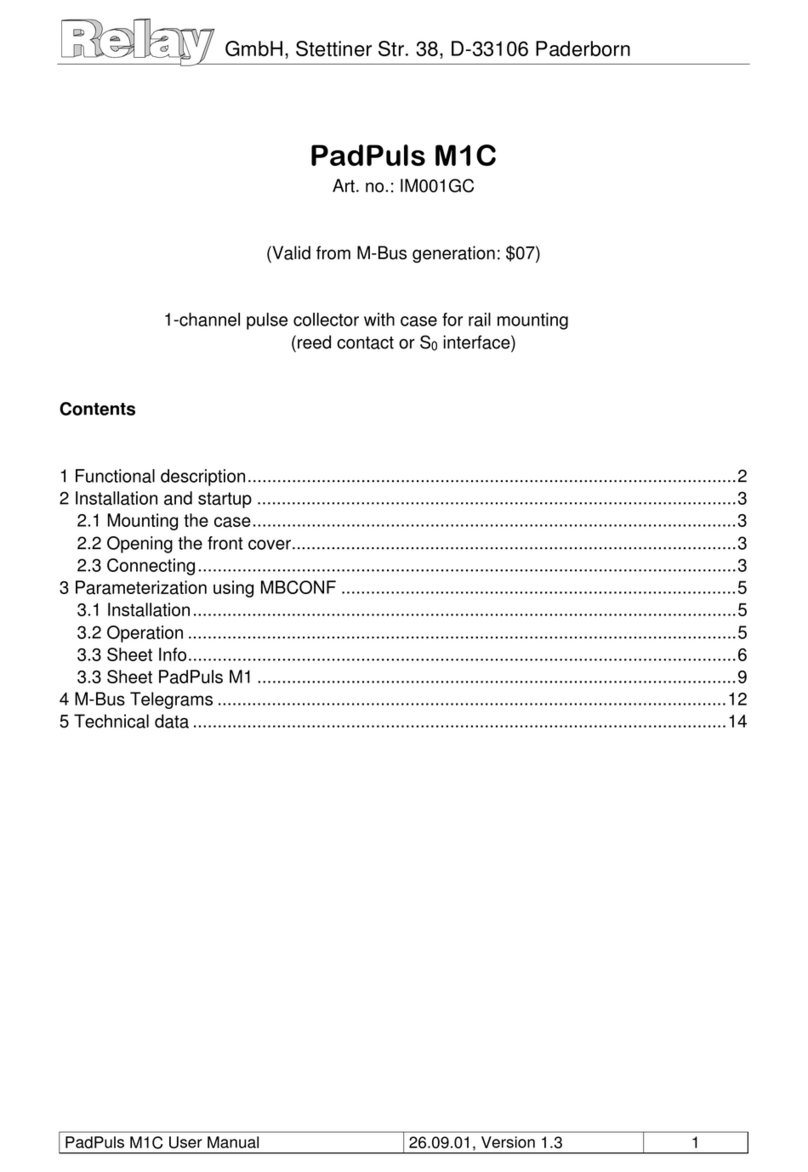Dataq DI-710 Series User manual

The way PC-based instrumentation should be
DI-710 Series
16-Channel USB or Ethernet data logger
DI-715B Series
Ethernet Data Logger with Signal-Conditioned Inputs
User's Manual
Manual Revision S
Copyright © 2009 by DATAQ Instruments, Inc. The Information contained herein is the exclusive property of
DATAQ Instruments, Inc., except as otherwise indicated and shall not be reproduced, transmitted, transcribed, stored
in a retrieval system, or translated into any human or computer language, in any form or by any means, electronic,
mechanical, magnetic, optical, chemical, manual, or otherwise without expressed written authorization from the com-
pany. The distribution of this material outside the company may occur only as authorized by the company in writing.
DATAQ Instruments' hardware and software products are not designed to be used in the diagnosis and treatment of
humans, nor are they to be used as critical components in any life-support systems whose failure to perform can rea-
sonably be expected to cause significant injury to humans.
DATAQ, the DATAQ logo, and WINDAQ are registered trademarks of DATAQ Instruments, Inc. All rights reserved.
Designed and manufactured in the
United States of America
M-100762


Warranty and Service Policy
Product Warranty
DATAQ Instruments, Inc. warrants that this hardware will be free from defects in materials and workmanship under
normal use and service for a period of one year from the date of shipment. DATAQ Instruments' obligations under
this warranty shall not arise until the defective material is shipped freight prepaid to DATAQ Instruments. The only
responsibility of DATAQ Instruments under this warranty is to repair or replace, at its discretion and on a free of
charge basis, the defective material.
This warranty does not extend to products that have been repaired or altered by persons other than DATAQ Instru-
ments employees, or products that have been subjected to misuse, neglect, improper installation, or accident.
DATAQ Instruments shall have no liability for incidental or consequential damages of any kind arising out of the sale,
installation, or use of its products.
Service Policy
1. All products returned to DATAQ Instruments for service, regardless of warranty status, must be on a freight-pre-
paid basis.
2. DATAQ Instruments will repair or replace any defective product within 5 days of its receipt.
3. For in-warranty repairs, DATAQ Instruments will return repaired items to the buyer freight prepaid. Out of war-
ranty repairs will be returned with freight prepaid and added to the service invoice.


v
CAUTION
READ BEFORE CONNECTING INPUT SIGNALS TO YOUR DI-710
The DI-710 data acquisition device you have purchased and are about to use is NOT an ISOLATED product. This
means that it is susceptible to common mode voltages that could cause damage to the device. SUCH DAMAGE IS
NOT COVERED BY THE PRODUCT’S WARRANTY. Please read the following carefully before deploying the
product. Contact DATAQ Instruments Support at 330-668-1444 for all questions. If you have purchased a DI-715B
you do not need to follow these instructions.
This product can tolerate a maximum applied voltage of only ±20V peak without damage. Although you may be cer-
tain that the signal you want to measure is lower than this level, a common mode voltage (CMV) with an unknown
value may combine with your signal of interest to exceed this ±20V limit. In such instances, the product will be dam-
aged. Verify a CMV does not exist before connecting signals and acquiring data with your device. Use the following
procedure to check for CMV:
1. DO NOT connect your data acquisition device to the device under test. If the device under test is connected to
your data acquisition device, disconnect it.
2. Connect your data acquisition device to the appropriate interface on your PC (USB, Ethernet, RS-232 Serial, or
Parallel Printer Port).
3. Apply power to your data acquisition device, your PC, and the device under test.
4. Use a digital voltmeter to make the following measurements:
a. Measure the voltage (both the AC and DC range) between the ground terminal of your data acquisition
device and Signal+ of the device under test. This measurement should not exceed the Full Scale Range of
your data acquisition device.
b. Measure the voltage (both the AC and DC range) between the ground terminal of your data acquisition
device and Signal- of the device under test. This measurement should be at or very near 0 Volts.
c. Measure the voltage (both the AC and DC range) between the ground terminal of your data acquisition
device and Common of the device under test. This measurement should be at or very near 0 Volts.
5. Should ANY of these measurements exceed their recommendation DO NOT CONNECT SIGNALS to the data
acquisition device. A common mode voltage may exist that could destroy the instrument. You MUST determine
the source of the CMV and eliminate it before taking any measurements.
1Measured signal is not to exceed the Full Scale Range of your data acquisition device.
2Measured signal must be at or very near 0 volts.
3Measured signal must be at or very near 0 volts.
4Connect to AGnd (Analog Ground) port on DI-710 instruments.
!
!
Device
Under
Test
Signal + 1
Signal - 2
Common3
Digital Voltmeter
Data
Acquisition
Device
To PC
Ground4


DI-710 Series and DI-715B Series Hardware Manual
Table of Contents
vii
Table of Contents
Warranty and Service Policy ................................................................................................................ iii
CAUTION ........................................................................................................................................... v
1. Introduction ........................................................................................................................................ 1
Features .............................................................................................................................................. 1
Analog Inputs .................................................................................................................................... 2
Digital Input and Output .................................................................................................................... 2
Software ............................................................................................................................................. 3
WinDaq® Recording and Playback Software ............................................................................ 3
The DATAQ Instruments Hardware Manager ............................................................................ 3
Help ............................................................................................................................................. 3
2. Specifications ...................................................................................................................................... 5
Analog Inputs .................................................................................................................................... 5
Digital I/O .......................................................................................................................................... 5
A/D Characteristics ............................................................................................................................ 6
Scanning Characteristics .................................................................................................................... 6
Calibration ......................................................................................................................................... 6
USB Interface .................................................................................................................................... 6
Ethernet Interface .............................................................................................................................. 6
Removable Memory (Stand-alone Models only) .............................................................................. 6
Real Time Clock ................................................................................................................................ 6
Controls (Stand-alone Models only) .................................................................................................. 6
Indicators ........................................................................................................................................... 7
Transfer Rate to PC ........................................................................................................................... 7
General ............................................................................................................................................... 7
3. Installation .......................................................................................................................................... 9
Unpacking .......................................................................................................................................... 9
Installing the Device Drivers (USB Only) ........................................................................................ 9
Installing an Ethernet Device Directly Connected to your PC or Connected via a Hub or Switch Where
ONLY DI-71x Products are Installed ...................................................................................................... 11
Installing an Ethernet Device via a Distributed Network Without a DHCP Server .......................... 14
Installing an Ethernet Device via a Distributed Network with a DHCP Server ................................ 16
Installing WinDaq Software and the Dataq Instruments Hardware Manager ................................... 16
Activation of WinDaq/High Speed Option ....................................................................................... 18
Dataq Instruments Hardware Manager .............................................................................................. 18
4. Instrument Controls, Indicators, and Connections ........................................................................ 21
Connecting the DI-710 to Ground ..................................................................................................... 21
Instrument Front Panel ...................................................................................................................... 22
DI-710 Models ............................................................................................................................ 22
37-pin D sub connector ........................................................................................................ 23
DI-715B Models ......................................................................................................................... 24
Instrument Rear Panel ....................................................................................................................... 25
DI-710 models ............................................................................................................................. 25
DI-715B Models ......................................................................................................................... 26
Connecting Signals ............................................................................................................................ 27
Controls and Indicators ...................................................................................................................... 27

DI-710 Series and DI-715B Series Hardware Manual
Table of Contents
viii
Expansion (DI-715B Models) ..................................................................................................... 27
Power Input Jack ......................................................................................................................... 27
Power Switch (DI-715B Models) ................................................................................................ 27
Ground ......................................................................................................................................... 27
Interface Port ............................................................................................................................... 28
Control Button (Stand-alone Models) ......................................................................................... 28
Start Recording ..................................................................................................................... 28
Stop Recording ..................................................................................................................... 28
Formatting the Memory Card ............................................................................................... 28
Reconfigure Instrument ........................................................................................................ 28
Fix Errors .............................................................................................................................. 28
Mode LED Indicator ................................................................................................................... 29
Removable Storage Slot (MMC) (Stand-alone Models) ............................................................. 29
Installing a Shunt Resistor in DI-715B Models ................................................................................. 29
5. Operation ............................................................................................................................................ 31
PC-connected Models ........................................................................................................................ 31
Enabling/Disabling the Digital I/O and Remote Control ............................................................ 31
Channel Configuration for the DI-715B ..................................................................................... 31
Enabling Channels ................................................................................................................ 31
Calibration and Gain Settings ..................................................................................................... 32
High/Low Calibration ........................................................................................................... 32
Fixed Calibration .................................................................................................................. 32
Gain ...................................................................................................................................... 33
Stand-alone Models ........................................................................................................................... 33
PC-connected operation .............................................................................................................. 34
Networked operation as a data acquisition server (DI-710-ELS, DI-710-EHS, and DI-715B-ES
models) ..................................................................................................................................................... 34
Stand-alone data logger operation ............................................................................................... 34
The Stand-alone Set Up Panel ..................................................................................................... 34
Operation ..................................................................................................................................... 34
Troubleshooting .......................................................................................................................... 35
If power down occurs unexpectedly while recording to MMC/SD ............................................ 36
WinDaq Waveform Browser for MMC ...................................................................................... 37
6. Block Diagram .................................................................................................................................... 39
DI-710 Models ................................................................................................................................... 39
DI-715B Models ................................................................................................................................ 40
7. Accessories .......................................................................................................................................... 41
The DI-705 ......................................................................................................................................... 42
Using the DI-705 with DI-710 “D” Models ................................................................................ 42
Using the DI-705 with DI-715B Instruments .............................................................................. 43
The DI-205 (for use with DI-710 “D” models) ................................................................................. 44
Input/Output Panel Interconnections ........................................................................................... 44
Digital I/O - Analog Output .................................................................................................. 44
Input Signal Configuration .......................................................................................................... 45
Connecting a Single-ended Amplifier .................................................................................. 45
Connecting a Differential Amplifier ..................................................................................... 46
Ground-referenced Signal Sources ................................................................................ 46
Isolated Signal Sources .................................................................................................. 48
Signal Cable and the Differential Amplifier .................................................................. 48
DI-75B Backpack (for use with DI-715B models) ............................................................................ 49

DI-710 Series and DI-715B Series Hardware Manual
Table of Contents
ix
Connecting the DI-75B to the Host Instrument .......................................................................... 49
Applying Power to the DI-75B ................................................................................................... 49
Features, Controls, and Indicators ............................................................................................... 50
DI-75B Front Panel .............................................................................................................. 50
DI-75B Rear Panel ............................................................................................................... 51
Removable Screw Terminal Block ................................................................................ 52
POWER switch .............................................................................................................. 52
POWER input jacks ....................................................................................................... 52
POWER status lamp ...................................................................................................... 52
POWER LOW lamp ...................................................................................................... 52
EXPANSION OUT connector ....................................................................................... 52
EXPANSION IN connector ........................................................................................... 52
Configuring Channels for the DI-75B ........................................................................................ 52
Calibration ............................................................................................................................ 53
Gain ...................................................................................................................................... 53
Installing Shunt Resistors ............................................................................................................ 53
DI-5B Modules .................................................................................................................................. 54
DI-5B30/31 Analog Voltage Input Modules, Narrow Bandwidth .............................................. 54
DI-5B32 Analog Current Input Modules .................................................................................... 55
DI-5B33 Isolated True RMS Input Modules .............................................................................. 56
DI-5B34 Linearized 2- or 3-Wire RTD Input Modules .............................................................. 57
DI-5B35 Linearized 4-Wire RTD Input Modules ....................................................................... 59
DI-5B36 Potentiometer Input Modules ....................................................................................... 61
DI-5B38 Strain Gage Input Modules, Narrow & Wide Bandwidth ........................................... 62
DI-5B40/41 Analog Voltage Input Modules, Wide Bandwidth ................................................. 64
DI-5B42 2-Wire Transmitter Interface Modules ........................................................................ 65
DI-5B43 Isolated DC Transducer Amplifier Input Module ........................................................ 66
DI-5B45 Frequency Input Modules ............................................................................................ 68
DI-5B47 Linearized Thermocouple Input Modules .................................................................... 69
DI-5B48 Accelerometer Input Modules ..................................................................................... 71


DI–710 Series and DI-715B Series Hardware Manual
Introduction
1
1. Introduction
Congratulations on your purchase of the DI-710 or DI-715B data logger/data acquisition system. DI-710 and DI-
715B Instruments feature a variety of options—each explained fully in this manual. Options include a USB or Ether-
net Interface, PGL or PGH gain settings, Stand-alone capability, and, for DI-715B instruments, thermocouple temper-
ature measurment capability using DI-5B47 modules. DI-715B models accept DI-5B Industrial Signal Conditioning
Modules. Use the table below to determine the options included with your Instrument.
Features
The DI-710 has the following features:
• Multiple Hardware options: USB or Ethernet Interface; PGL or PGH gain settings; and Stand-alone data logger
Operation capabilities. All options available in any configuration.
• Per channel software-configurable settings: Single-ended or differential input; input gain; and calibration.
• 4,800 samples/second maximum sampling rate—up to 14,400 samples/second when recording to a memory card.
• 0.048 samples/second minimum sampling rate—0.0017 samples/second when recording to a memory card.
• 14-bit A/D converter for high resolution measurement accuracy.
• 16-entry input scan list allows you to scan any sequence of input channels at any available gain.
• The Stand-alone option allows the user to configure a recording session through their PC then record data in the
field to a memory card (SD or MMC) without being connected to their PC.
The DI-715B has the following features:
• Accepts up to 8 DI-5B Modules accommodating virtually any industrial signal.
• Per channel software-configurable settings: input gain settings of 1, 2, 4, 8; calibration.
• 4,800 Hz maximum sampling rate—up to 14,400 Hz when in Stand-alone data logger operating mode.
• 0.048 samples/second minimum sampling rate—0.0017 samples/second when recording to a memory card.
Model No.
Options
Ethernet USB -H Gain -L Gain Stand-alone Accepts 5B Modules
DI-710-UH* N Y Y N N N
DI-710-UHS* N Y Y N Y N
DI-710-UL* N Y N Y N N
DI-710-ULS* N Y N Y Y N
DI-710-EH* Y N Y N N N
DI-710-EHS* Y N Y N Y N
DI-710-EL* Y N N Y N N
DI-710-ELS* Y N N Y Y N
DI-715B-E Y N Y N N Y
DI-715B-ES Y N Y N Y Y
*All DI-710 models available with a 37-pin D sub connector (as opposed to two removable 16-port screw termi-
nal blocks). Add “D” to the model number. See "37-pin D sub connector" on page 23.

DI–710 Series and DI-715B Series Hardware Manual
Introduction
2
• 14-bit A/D converter for high resolution measurement accuracy.
• 16-entry input scan list allows you to scan any sequence of input channels at any available gain.
• The Stand-alone option allows the user to configure a recording session through their PC then record data in the
field to an SD card (without being connected to their PC).
Analog Inputs
DI-710 models provide 16 single-ended or 8 differential analog inputs (programmable per channel) that allow your
analog signals to be converted into 14-bit digital data via an on board A/D converter. Two removable 16 position ter-
minal blocks allow you to easily connect and record signals. The DI-710 features the following software-programma-
ble input measurement ranges:
DI-715B models provide 16 fixed single-ended analog inputs that allow your analog signals to be converted into 14-
bit digital data via an on board A/D converter. Differential input is not supported. Channels 9-16 are accessible
through use of a DI-705 (see "The DI-705" on page 42). The DI-715B features the following software-programmable
input measurement ranges:
Digital Input and Output
All DI-710 and DI-715B models contain 8 software-programmable digital lines (bits) for input/output operations.
These lines provide an interface for the transfer of data between user memory and a peripheral device connected to
the instrument. Digital inputs can monitor alarms or sensors with TTL outputs, while digital outputs can drive TTL
inputs on control or measurement equipment. Remote control can be utilized with bits 0 and 1 and is easily accessed
using WINDAQ Acquisition software or, for stand-alone models, in the stand-alone setup panel. To avoid using an
analog input channel for Digital I/O, Channel 17 may be enabled as the digital channel. To use the Remote Control
features in WINDAQ Acquisition software either Channel 1 or Channel 17 must be configured as the Digital Input
channel. The digital bits on a DI-715B are only accessible through a DI-705 (see "The DI-705" on page 42).
-L Models -H Models
±10V full scale measurement range at a gain of 1 ±10V full scale measurement range at a gain of 1
±1V full scale measurement range at a gain of 10 ±5V full scale measurement range at a gain of 2
±100mV full scale measurement range at a gain of 100* ±2.5V full scale measurement range at a gain of 4
±10mV full scale measurement range at a gain of 1000* ±1.25V full scale measurement range at a gain of 8
*Gains of 100 and 1000 are limited to max throughput of 7200 and 900 Hz respectively when acquiring more than
one channel of data.
Measurement Range Gain Setting
±10V full scale 1
±5V full scale 2
±2.5V full scale 4
±1.25V full scale 8

DI–710 Series and DI-715B Series Hardware Manual
Introduction
3
Software
All software required to record and playback waveforms is included with the purchase of any DI-710 or DI-715B
model including WINDAQ Acquisition and Playback software and the Dataq Instruments Hardware Manager.
WINDAQ®Recording and Playback Software
WINDAQ Acquisition and WINDAQ Waveform Browser allow you to record and playback data acquired through your
instrument. Whether using a Stand-alone model or a PC-connected instrument, WINDAQ is an invaluable resource to
analyzing your data. A special version (see "WinDaq Waveform Browser for MMC" on page 37) of WINDAQ Wave-
form Browser (free) is required to read waveform data recorded to a Memory Card but is easily transferred to the
standard version for more analytical features.
WINDAQ Acquisition software can be used to record waveforms directly and continuously to disk while monitoring a
real time display of the waveforms on-screen. It operates and displays waveform signals in real time at the full sample
rate of the instrument being used. There are two versions of WINDAQ Acquisition software available for use with DI-
710 and DI-715B Instruments: WINDAQ/Lite and WINDAQ/High Speed option. WINDAQ/Lite is free but is restricted
to recording throughput rates of 1108 Hz with a DI-710 or DI-715B. WINDAQ/High Speed option is an extra-cost
option allowing you to record data at the speed of your data acquisition system. When you install the software, a trial
version of WINDAQ/High Speed is automatically installed allowing you to run the software for a limited time. Activa-
tion is required for continued use to ensure compliance with the Software License Agreement. This software is
accessed through the Dataq Instruments Hardware Manager which can be found in the Start menu under the WINDAQ
program group called Dataq Instruments Hardware Manager.
WINDAQ Waveform Browser playback software (also known as “WWB”) offers an easy way to review and analyze
acquired waveforms. A built-in data file translator allows the user to display multiple waveforms acquired by
WINDAQ Acquisition software or any of a wide range of data acquisition packages. The software’s disk-streaming
design allows data files of any length to be graphically displayed rapidly, in normal or reverse time directions. Seven
standard cursor-based measurements, frequency domain, and statistical analysis functions help simplify waveform
analysis and interpretation. WINDAQ Waveform Browser is free and installed when installing WINDAQ Software.
The DATAQ Instruments Hardware Manager
The DATAQ Instruments Hardware Manager allows you to effectively manage and run multiple instruments installed
and connected to your PC or your Network—or even over the internet. This software can be found in the Start menu
under the WINDAQ program group called Dataq Instruments Hardware Manager. Access WINDAQ Acquisition
software, Upload data from your memory card, check the Status of your memory card, Format your memory card,
configure a Stand-alone data acquisition session, setup the Digital I/O, and more in this easy-to-use point and click
environment. View the Help files by clicking on View Help in the Help menu or by pressing F1.
Help
All WINDAQ software utilizes context-sensitive help. Help may be accessed through the Help menu or by pressing the
F1 key with any feature selected. This will take you directly to the Help topic most relevant to that particular function
or feature. Help topics discuss in detail each function available in the software.


DI–710 Series and DI-715B Series Hardware Manual
Specifications
5
2. Specifications
Unless otherwise noted, specifications are for all DI-710 and all DI-715B instruments.
Analog Inputs*
Number of Channels: DI-710: 16
DI-715B: 8 configured for signal conditioned inputs and 8 direct con-
nections
Channel Configuration: DI-710: 16 single ended, 8 differential, programmable per channel
DI-715B: Fixed single ended
Input Impedance, single-ended: 1MΩ
Input Impedance, differential: 1MΩeach input to common
Input bias current: 10µA for a 10V input, single channel
Input offset voltage: Auto-zero
Input offset current: 2nA (single channel)
Maximum normal mode voltage (DI-710): 30V DC or peak AC
Maximum common mode voltage: 30V DC or peak AC
Common mode rejection (DI-710): 80db, gain=1, 1KΩ unbalance
Channel-to-Channel crosstalk rejection: -75db @ 100Ω unbalance
Gain temperature coefficient: 50ppm/°C
Offset temperature coefficient: 0.25µV/°C
Digital Filtering: PC-connected models: Conditional over-sampling
Stand-alone models: None
Analog measurement range (software selectable per channel), Accuracy, and Resolution:
DI-710-L Models DI-710-H and DI-715B Models
Gain Range Accuracy** Resolution Gain Range Accuracy** Resolution
1±10V ±.05%FSR ±50µV ±1.22mV 1 ±10V ±.05%FSR ±50µV ±1.22mV
10 ±1V ±.05%FSR ±50µV ±122µV 2 ±5V ±.05%FSR ±50µV ±610µV
100 ±100mV ±.05%FSR ±50µV ±12.2µV 4 ±2.5V ±.05%FSR ±50µV ±305µV
1000 ±10mV ±.05%FSR ±50µV ±1.22µV 8 ±1.25V ±.05%FSR ±50µV ±153µV
*DI-715B Models: These specifications are for the unit itself (excluding DI-5B module(s))
**Test Condition: Single channel, 100 S/s, averaging mode. For DI-715B this spec doesn’t include 5B or CJC error.
Digital I/O
Channels: 8 bi-directional bits
Configuration: Each bit is programmable as an input or output
Output voltage levels: Minimum “1”, 3V @ 2.5mA sourcing; Maximum “0”, 0.4V @ 2.5mA
sinking
Output current: Maximum source, -2.5mA; Maximum sink, 2.5mA
Input voltage levels: Minimum required “1”, 2V; Maximum allowed “0”, 0.8V

DI–710 Series and DI-715B Series Hardware Manual
Specifications
6
A/D Characteristics
Type: Successive Approximation
Resolution: 14-bit
Monotonicity: ±2 LSB
Conversion Time: 69µs
Scanning Characteristics
Maximum sample throughput rate:* PC-connected: 4,800 Hz Stand-alone: 14,400 Hz**
*When acquiring more than one channel at a gain of 100 max throughput is 7200 Hz;
When acquiring more than one channel at a gain of 1000 max throughput is 900 Hz.
**Assumes SD memory latencies of 80 milliseconds or less.
Minimum sample throughput rate: PC-connected: 0.0034 Hz Stand-alone: 0.0017 Hz
Maximum scan list size: 17 entries
Sample buffer size: 2kb
Calibration
Calibration Cycle: One year
USB Interface
Connector: USB
Protocol: USB 1.1
Ethernet Interface
Type: 10/100Base-T
Connector: RJ-45
Protocol: TCP/IP
Server Type: DHCP
Removable Memory (Stand-alone Models only)
Type: Secure Digital (SD)
Capacity: 16MB to 2GB
Real Time Clock
Type: Date, hour, minute, second
Resolution: 1 second
Accuracy: 20 ppm
Controls (Stand-alone Models only)
Single push-button: Provides manual control over Record and Standby modes.

DI–710 Series and DI-715B Series Hardware Manual
Specifications
7
Indicators
Stand-alone models: Three color LED indicating Record, Standby, and Error conditions.
PC-connected models: Power LED
Transfer Rate to PC
Real Time: up to 4,800 samples per second
From MMC or SD Memory (Ethernet
models only): up to 2,400 samples per second
General
Panel Indicators: Mode LED
Panel Controls: Control push-button (Stand-alone models)
Panel slots: Accepts MMC/SD-type flash memory
Input connectors: DI-710: Two, removable sixteen position terminal blocks
DI-715B: One removable 32 port screw terminal block
Operating Environment: 0°C to 70°C
Enclosure: DI-710: Aluminum base with steel wrap-around. Aluminum end-panels
with plastic bezels.
DI-715B: Aluminum base with steel wrap-around. Clear acrylic front
panel.
Dimensions: DI-710: 5.4 D x 4.1 W x 1.5 H in. (13.81D x 10.48W x 3.81H cm.)
DI-715B: 9 D x 7.29 W x 2.7 H in. (22.86D x 18.52W x 6.86H cm.)
Weight: DI-710: 14 oz. (397 grams)
DI-715B: 3 lbs. (1.36 kg)
Power Requirements: DI-710 USB products: 9 to 36 VDC, 2 watts maximum
DI-710 Ethernet products: 9 to 36 VDC, 2.5 watts maximum
DI-715B USB products: 9 to 36 VDC, 2 watts + 5B modules
DI-715B Ethernet products: 9 to 36 VDC, 2.5 watts + 5B modules


DI–710 Series and DI-715B Series Hardware Manual
Installation
9
3. Installation
Unpacking
The following items are included with each instrument. Verify that you have the following:
• DI-710 Series or DI-715B Series Instrument.
• Communications cable (USB ONLY - Ethernet models do not come with an Ethernet cable).
• Power cable (except DI-710-UL and DI-710-UH).
• The WINDAQ Resource CD-ROM.
• DATAQ screwdriver for connecting signal leads to the screw terminal(s).
• Installation Guide pamphlet (included in CD case).
If an item is missing or damaged, call DATAQ Instruments at 330-668-1444. We will guide you through the appropri-
ate steps for replacing missing or damaged items. Save the original packing material in the unlikely event that your
unit must, for any reason, be sent back to DATAQ Instruments.
Installing the Device Drivers (USB Only)
These USB devices require two drivers to be installed (a Serial Port and a USB driver). Ethernet models do not
require any drivers to be installed (See “Installing WinDaq Software and the Dataq Instruments Hardware Manager”
on page 16. to install Ethernet products).
1. If provided, plug the appropriate end of the power cable into the instrument (jack labeled Power) and the other
end into a standard outlet. DI-710-UL and DI-710-UH models do not require an external power source. Power is
derived from the PC through the USB interface. For DI-715B models turn on the power using the Power Switch.
The Mode LED will be on when power is applied.
2. With your computer powered, Windows running, and all other applications closed, plug the appropriate end of
the supplied USB communications cable into the USB port (labeled Interface) on the rear panel of the instru-
ment. Connect the other end of this cable to one of your computer's USB ports.
Note: If using a USB hub with a DI-710-UH or DI-710-UL use a powered USB hub—non-powered USB hubs
may not have sufficient power to run the instrument.
3. The addition of this new piece of hardware will be “sensed” by Windows and the “Found New Hardware Wiz-
ard” will automatically be launched, anticipating the installation of a device driver for the new hardware. If the
Wizard asks “Can Windows connect to Windows Update to search for software?” select “No, not this time” and
click on the Next button.
4. Insert The WINDAQ Resource CD-ROM into your CD-ROM drive. It contains the device drivers for the DI-710
and DI-715B. If your Windows auto play feature is enabled, the WINDAQ Software Installation will start. Click
on the Exit button to leave the installation.
5. Click through the defaults. When completed, the “Found New Hardware Wizard” will run again - and again you
should click through the defaults until you exit the Wizard. The DI-710 and DI-715B USB models require two
drivers to be installed, a Serial Port and a USB driver. This will look like two instruments are installed when
there is only one.

DI–710 Series and DI-715B Series Hardware Manual
Installation
10
Note: If you receive the Microsoft-issued warning that the software “has not passed Windows Logo testing” click
“Continue Anyway” to continue with installation. You will see this warning twice - once for each driver (USB
and Serial Port).
6. After the Drivers are installed, click Finish to close the Found New Hardware Wizard. Windows should prompt
you that the device has been installed properly.
7. Repeat this process for each instrument. After all device drivers have been installed, install WINDAQ software
(see “Installing WinDaq Software and the Dataq Instruments Hardware Manager” on page 16).
XP warning
Vista Warning
This manual suits for next models
1
Table of contents
Other Dataq Data Logger manuals
Popular Data Logger manuals by other brands

LogTag Recorders
LogTag Recorders UTREL30-16-WIFI Product user guide

GHM Greisinger
GHM Greisinger EASYLOG 80NS Series Installation and operating manual
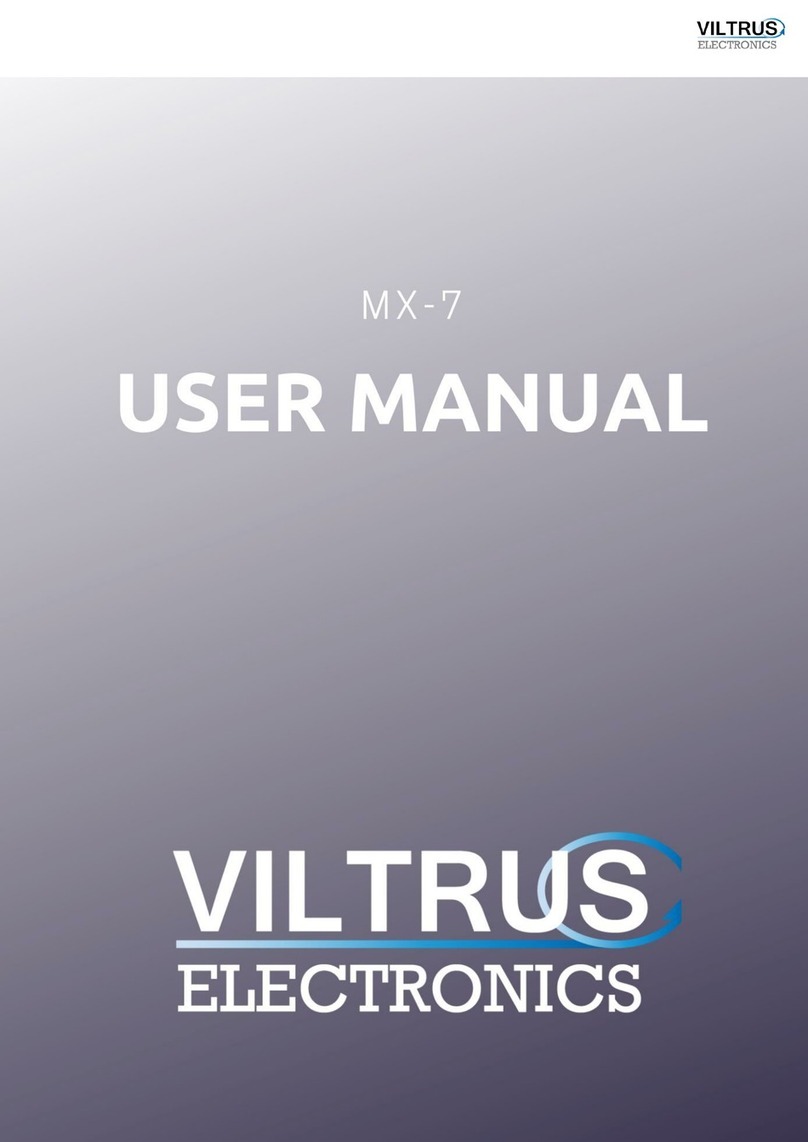
Viltrus Electronics
Viltrus Electronics MX-7 user manual
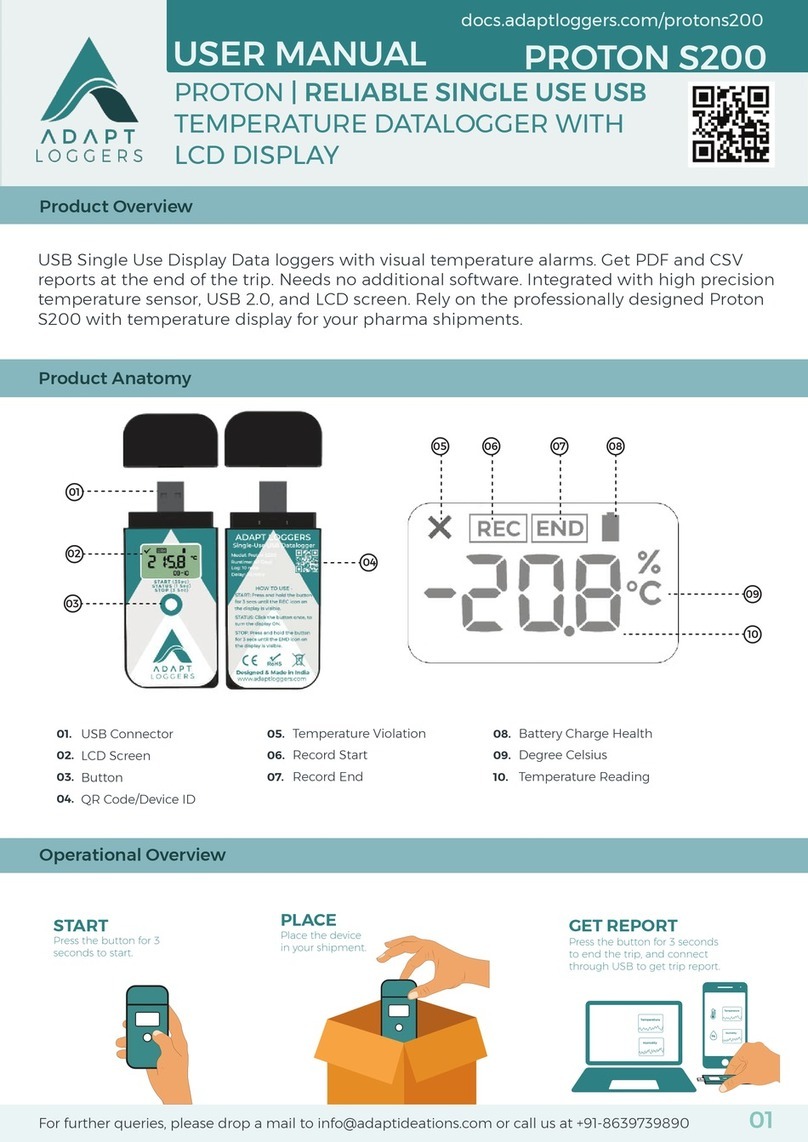
ADAPT LOGGERS
ADAPT LOGGERS PROTON S200 user manual

Ahlborn
Ahlborn ALMEMO 500 Supplementary instructions manual
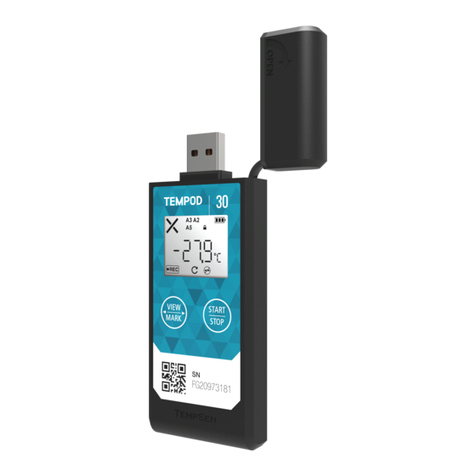
TempSen
TempSen Tempod 30 user manual

